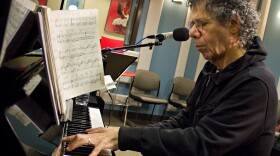Listen to the story above or read the script below:
You may know New Orleans style jazz or Chicago blues but Kansas City, geographically situated as a working town on the road from the birthplace of jazz to the windy city, was where the music shifted away from structured big bands to a more improvisational style.
Black-led bands of the '20s and '30s embodied the Midwestern big band sound. Bands led by Count Basie, Andy Kirk and Bennie Moten.
The first band from Kansas City to get a national notice was the Coon-Sanders Original Nighthawk Orchestra, a white group which broadcast nationally in the 1920s.
But the Kansas City jazz style made the national jazz scene in the mid-30s when record producer John Hammond heard the Count Basie orchestra on the radio broadcasting from Kansas City, and shortly after, brought them to New York.
It was fast and swinging…the kind of music that would keep dancers working up a sweat for hours! And hours they played. One of the defining factors in the Kansas City sound was the hours spent playing all night.
The reason for that, political boss Tom Pendergast enabled clubs to sell liquor and stay open all-hours which fueled the live jazz scene – even in the prohibition era of the day. It was in those late night musical free-for-alls that led to friendly competition which sparked a new style of improvisational music. Variations on just one song could last for hours. Bandleader Jay McShann said:
"You'd hear some cat play, and somebody would say 'This cat, he sounds like he is from Kansas City.' It was Kansas City's style. The scene was so well known, it even inspired song writers who had never been to the city.
The actual corner of 18th Street and Vine was the center of the Kansas City jazz universe. Clubs like Amos 'n' Andy, Chocolate Bar and Old Kentucky Bar-B-Que, all hosted the swinging jams.
What were the differences that made a “Kansas City” jazz sound?
A 4-beat feel – like walking – instead of the 2-beat feel found in other styles which gave the music a more relaxed, fluid sound.
The KC big bands played from memory rather than sight-reading as other big bands of the time. Composing and arranging the music collectively.
A heavy blues influence often based around a 12-bar blues structure, rather than the 32-bar format, made the Kansas City sound loose and spontaneous! Perfect for that nonstop nightlife.
One of Basie’s signature tunes show the memorized arrangements punctuated with solos. By the late 1930s, the style had ‘rubbed off’ on the larger musical world including the renown, Glenn Miller. "In the Mood" closely follows this Kansas City pattern of riffing sections.
Eventually the city cracked down on the clubs which largely ended the era.
But big band swing and improvisational jazz continued to capture the heart and dancing feet of Kansas Citians as well as the rest of the world!
Even today - The annual "Kansas City Blues and Jazz Festival" attracts top jazz stars and large out-of-town audiences and The American Jazz Museum is a jazz museum in the historic 18th and Vine district of Kansas City. The museum preserves the history of American jazz music.








